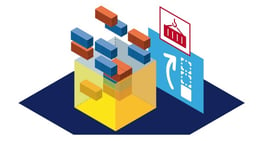How to Make the Most of the Industry 4.0 Supply Chain
Brian Hoey - January 16, 2018

 It’s been said that we should think of scientific revolutions not as revolutions per se, but as paradigm shifts—meaning that, rather than thinking of the great breakthroughs in 20th century physics or medicine as groundbreaking seismic shifts, we should consider them in terms of reorientations of method and changing understandings of old knowledge. The same might well be said of new developments in industry. The rise of automation, for instance, didn’t do away with the use of manpower overnight. Instead, it led us to reconsider the way we utilize people as resources and the way that we structure processes around manual intervention.
It’s been said that we should think of scientific revolutions not as revolutions per se, but as paradigm shifts—meaning that, rather than thinking of the great breakthroughs in 20th century physics or medicine as groundbreaking seismic shifts, we should consider them in terms of reorientations of method and changing understandings of old knowledge. The same might well be said of new developments in industry. The rise of automation, for instance, didn’t do away with the use of manpower overnight. Instead, it led us to reconsider the way we utilize people as resources and the way that we structure processes around manual intervention.
What does this way of thinking mean for how we discuss “the fourth industrial revolution,” i.e. Industry 4.0? Simply put, the tremendous potential benefits of Industry 4.0 won’t happen on their own. Yes, manufacturing as a field will change drastically and factories will become smarter and more reliant on sensors and internet of things (IoT) devices, but companies need to make an active engagement with these changes by learning to rethink their processes and their use of resources across the supply chain. This raises an important question: how can companies make the most of this new paradigm shift?
End-to-end Visibility
In procurement processes, businesses are often warned against “shadow IT,” situations in which information technology decisions are made either without explicit organizational buy-in or without the involvement of actual IT professionals. This can be the result of numerous factors, but it most commonly stems from the unclear lines of communication and incomplete data that result from siloized procurement processes. The same sort of murkiness and confusion frequently occurs in supply chain management, particularly in complex and variant-rich areas, with key stakeholders and decision-makers cut off from one another and potentially working at cross-purposes.
Industry 4.0 systems, with their emphasis on collecting mission critical data from sensors, have the potential to mitigate these sorts of decision-making siloes. With the new data being made available to them, manufacturers can make a push toward End-to-end (E2E) visibility. By making real-time data available throughout an entire organization, it is possible to illuminate the entire supply chain, giving stakeholders the power to make smarter, better informed decisions while boosting cross-operational planning and communication. Ultimately, businesses will be able to gain a more holistic, point-to-point view of their value chain and promote increasingly transparent manufacturing processes.
Intelligent Planning
E2E visibility is a noble goal for its own sake, but it can also help businesses bring about improvements that will radically change the Industry 4.0 supply chain. In particular, increased data visibility makes it possible for manufacturers to adopt intelligent planning solutions that respond to real-time inputs to demystify interrelated, variant-rich processes. When each value point from inbound stream to factory floor to customer delivery is digitized, made transparent, and more thoroughly understood, production sequences can be newly optimized, with areas of waste and inefficiency identified and remedied. An agile intelligent planning architecture should account for transport volumes, warehouse holdings, inventory levels, and potential disruptions and bottlenecks in order create production plans that are transparent, adaptable, and ultimately more cost-effective.
Where old-school strategic, operational, and tactical plans formed in an Excel spreadsheet might have sufficed in an era of limited connectivity, getting the most out of Industry 4.0 supply chains means adapting to new technological realities with an intelligent planning architecture that offers new capabilities, including:
- Integrated reporting and analysis
- Reevaluation of supply streams from a logistical standpoint
- Analysis of past demand and hurdles
Forecasting and Simulations
Although factories throughout the world are changing rapidly to include “smart” technology and capabilities, a recent survey showed that only 28% of manufacturers ranked themselves as “advanced” when it came to digitization. But as we’ve seen above, making the most of a smart factory means embracing new technology and information and integrating them into new processes and systems. This means, among other things, digitization. The power of a digitized Industry 4.0 supply chain is immense.
- Businesses can create “digital twins” in order to run simulations and test possible process changes on fully digital models of their manufacturing processes. Real-time data and sensors make it possible to keep a simulated factory precisely calibrated to the real-world conditions of its physical counterpart, enabling planners to accurately test predictions about process changes and navigating roadblocks.
- Integrated software solutions can develop more accurate forecasts for modeling future demand spikes/dips, predicting bottlenecks, and managing capacity usage. This enables planners to build more adaptive strategies, better cope with disaster scenarios (e.g. natural disasters along transport routes)/improve risk management across the entire supply chain, and minimize late deliveries to more accurately meet customer expectations/demand.
- Predictive, future-oriented planning can offer easier S&OE, more efficient supply chain management, and more broadly scoped business stratagems, paving the way for significant value added possibilities.
If indeed we think of these new frontiers in the supply chain as a paradigm shift, practices like intelligent planning and smarter forecasting can offer manufacturers not just new ways to improve processes, but a new way of looking at resources across all value points on the Industry 4.0 supply chain.
LATEST POSTS
- Understand Circular Economy in The Manufacturing Industry
- How Can Industry 4.0 IT Integration Be Achieved Smoothly?
- The Significance of Order Sequencing in Discrete Manufacturing
- How to improve your Supply Chain Management: The Power of Control Towers
- Optimizing Human Resource Scheduling in Manufacturing: A Technological Approach



